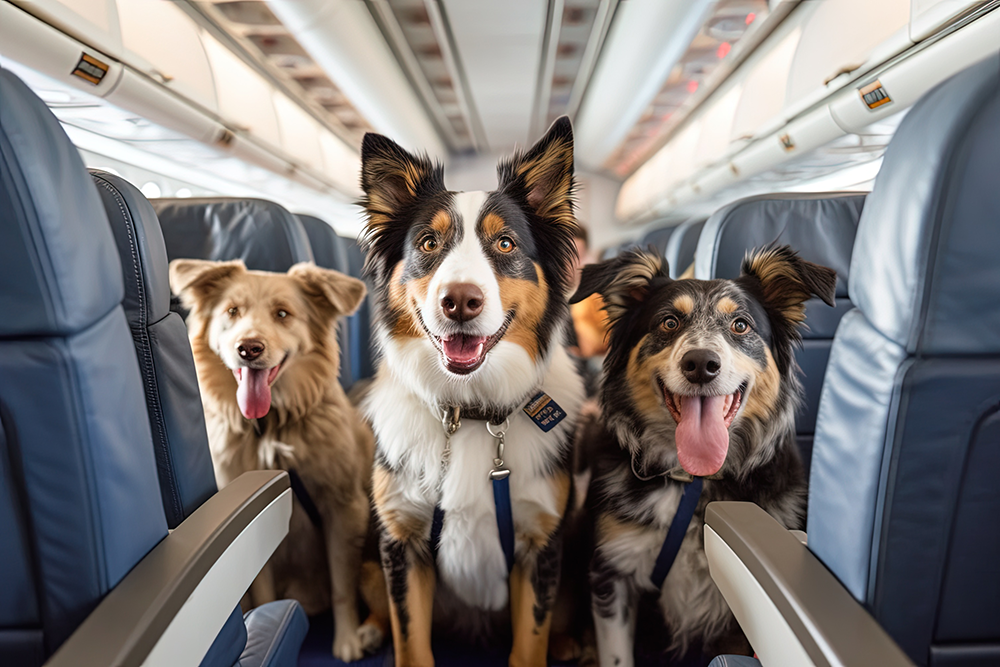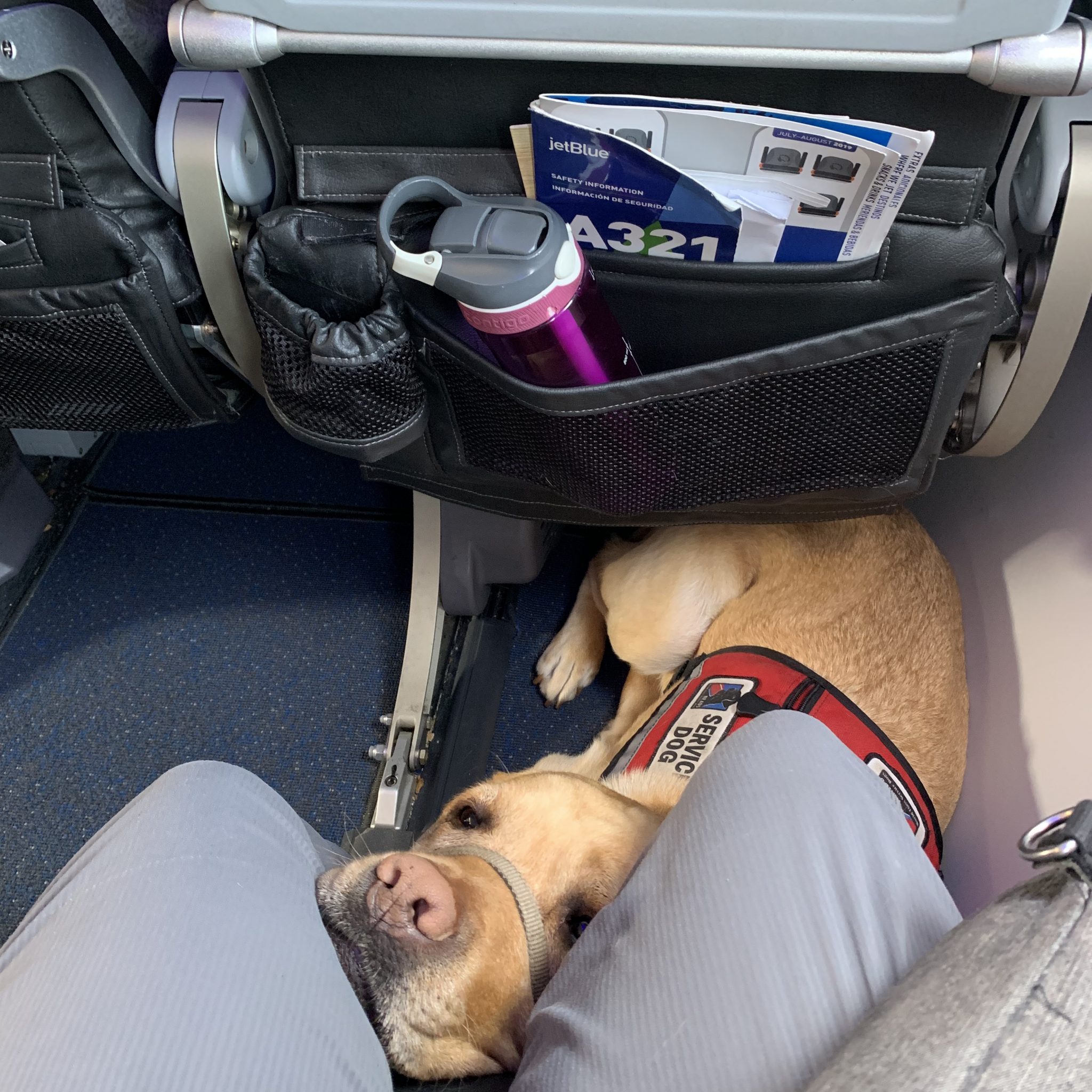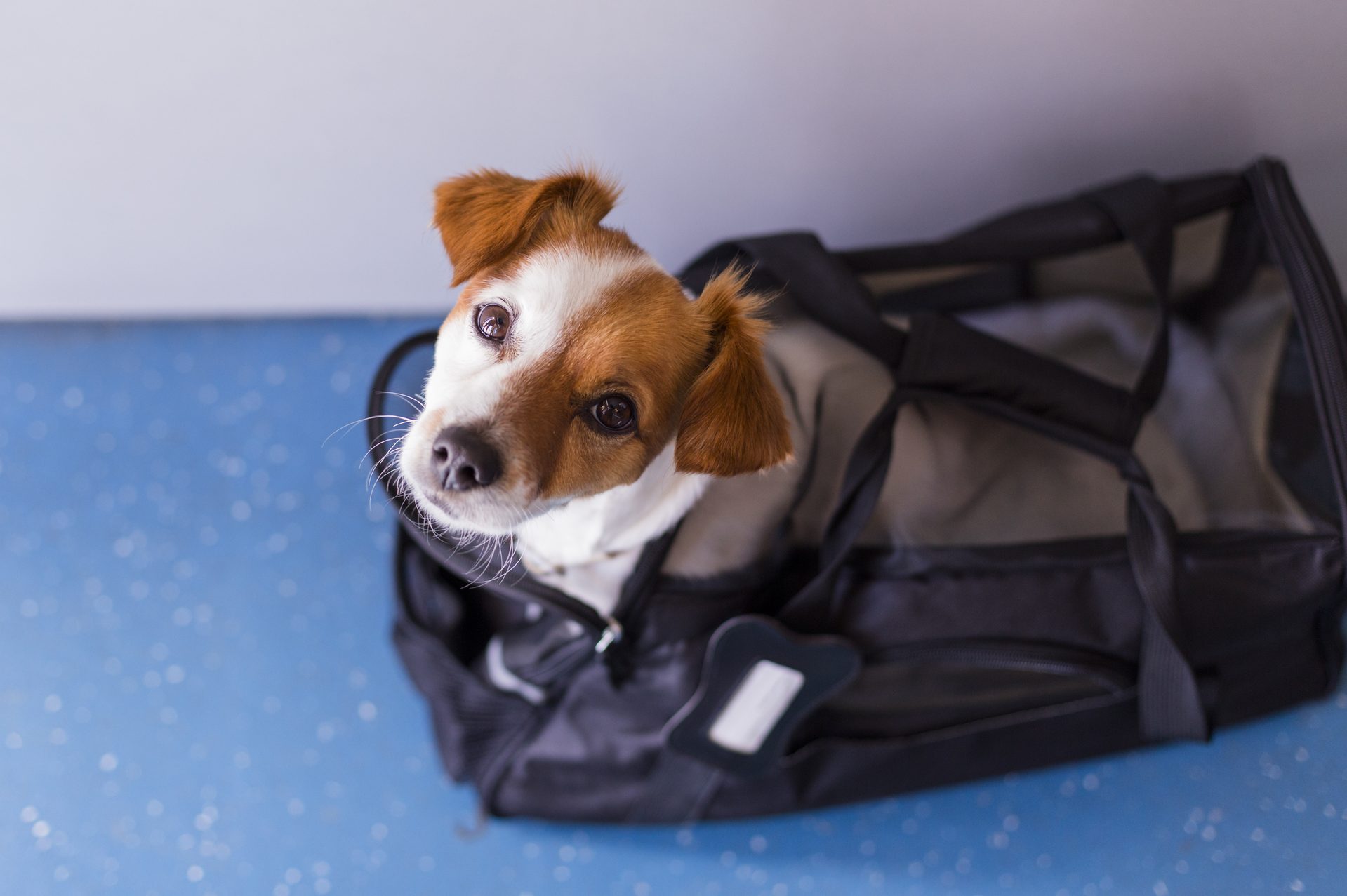Flying with dogs can be a manageable experience by following airline regulations and preparing in advance. Flying with dogs can be made easier by understanding the rules set by airlines and planning ahead.
Traveling with our furry friends is becoming increasingly common as more and more people consider their pets as part of the family. Many pet owners choose to fly with their dogs for various reasons, whether it be for a vacation, a family visit, or a permanent move.
However, navigating the process of flying with dogs can be daunting, especially for first-time travelers. Understanding airline regulations, preparing your dog for the journey, and ensuring their comfort and safety are crucial steps to ensure a smooth and stress-free experience. We will outline the essential information you need to know when flying with dogs, helping you to plan and prepare for a hassle-free journey.
Preparing Your Dog For A Flight
Flying with dogs can be a convenient and exciting way to travel with your furry friend. However, ensuring that your dog is prepared and comfortable for the journey is crucial. In this section, we will discuss the necessary steps to prepare your dog for a flight. From obtaining the necessary documentation to getting your dog accustomed to the carrier, these tips will help make the experience much more enjoyable for both of you.
Obtaining The Necessary Documentation
Before embarking on a flight with your dog, it is essential to gather all the necessary documentation. This ensures a smooth travel experience and avoids any last-minute complications. Here is a checklist of the documents you need:
- Health Certificate: A health certificate issued by your veterinarian is required by airlines to confirm your dog’s good health. This certificate should be dated within a certain timeframe, typically within 10 days of the flight.
- Vaccination Records: Ensure your dog’s vaccinations are up to date and keep a copy of the records handy. Some airlines may require proof of vaccinations, so it is best to be prepared.
- Identification Tags and Microchip: Double-check that your dog’s identification tags are securely attached to their collar. Additionally, consider microchipping your dog as an extra safety measure in case they get separated from you during the journey.
Getting Your Dog Comfortable With The Carrier
Traveling by air means that your dog will need to spend a significant amount of time in a carrier. To help them adjust and feel comfortable, follow these steps:
- Introduce the Carrier Early: Start by familiarizing your dog with the carrier well in advance. Place it in a common area at home and gradually encourage your dog to enter it, using treats or toys as rewards.
- Make it Cozy: Line the carrier with a soft blanket or bedding to make it cozy and inviting for your dog. Familiar scents can also help ease their anxiety during the journey.
- Practice with Short Trips: Take your dog for short drives in the carrier to simulate the experience of being in a moving vehicle. Gradually increase the duration of these trips to help your dog become accustomed to the carrier’s motion.
- Positive Reinforcement: Reward your dog each time they enter the carrier willingly and remain calm inside. This positive association will help reduce any fear or stress associated with being in the carrier.
By obtaining the necessary documentation and familiarizing your dog with the carrier, you can ensure a smooth travel experience for your four-legged companion. With proper preparation and care, flying with your dog can be an enjoyable adventure for both of you.

Credit: rochsociety.com
Choosing The Right Carrier
Choosing the right carrier is crucial when flying with dogs. Ensure your furry friend’s safety and comfort with a carrier that meets airline regulations and provides adequate ventilation and visibility.
When it comes to flying with your furry friend, choosing the right carrier is of utmost importance. The right carrier will not only ensure your dog’s comfort and safety, but also meet the size and weight requirements set by the airline. Let’s take a closer look at the key factors to consider when selecting a carrier for your canine companion.
Size And Weight Requirements
In order to travel smoothly with your dog, it’s crucial to adhere to the size and weight requirements set by the airline. Different airlines have different policies, so it’s essential to check with your specific airline before purchasing a carrier.
Airlines usually specify the maximum dimensions and weight allowed for pet carriers. Ensure the carrier you choose falls within these requirements to avoid any complications or additional charges at the airport. Keep in mind that airlines may measure your carrier at the check-in counter, so accurate measurements are vital.
Comfort And Safety Features
Comfort and safety should be your top priorities when selecting a carrier for your dog. A comfortable carrier will keep your furry friend at ease during the flight, creating a stress-free travel experience for both of you.
Look for carriers that provide ample ventilation to ensure proper airflow and prevent your dog from overheating. Consider carriers with mesh panels or ventilated sides that allow for maximum breathability.
Additionally, choose carriers that have secure closures, such as zippers or latch mechanisms, to keep your dog safely contained throughout the journey. Adjustable straps and handles will also make it easier for you to carry the carrier comfortably.
Moreover, providing a soft and cozy interior with a cushioned base or bedding will ensure your dog’s comfort throughout the flight. A carrier with an easily removable and washable lining will make it convenient to keep the carrier fresh and clean.
Remember to tag the carrier with your contact information, including your name and phone number, in case it gets misplaced or lost during transit.
In conclusion, when flying with your dog, choosing the right carrier is essential for a smooth and stress-free travel experience. Ensure the carrier meets the size and weight requirements and provides adequate comfort and safety features. By selecting the perfect carrier, you can ensure your furry friend’s well-being and make the journey as enjoyable as possible.
Navigating The Airport
Navigating the airport with your furry companion can be a breeze with these helpful tips. From checking regulations to ensuring their comfort, flying with dogs can be stress-free when you plan ahead and follow the proper procedures.
Checking In Your Dog
When it’s time to take to the sky with your furry friend, ensuring a smooth check-in process is essential. When heading to the airport, be sure to arrive early to allow ample time for the check-in process. Most airlines require that you check in your dog with an agent at the ticket counter. You will need to provide the necessary documentation, such as vaccination records and a health certificate, if required. Be prepared to answer any questions about your dog’s temperament or any special requirements they may have during the journey.Security Screening Procedures
Just like humans, dogs are subject to security screening procedures when flying. Before proceeding to the security checkpoint, ensure your dog’s leash, collar, and any other accessories are removed. At the security checkpoint, you will carry your dog while walking through the metal detector. It is possible that you may be required to place your dog’s carrier or harness through the X-ray machine separately. Remember to stay calm and follow the instructions given by the security personnel to ensure a hassle-free experience for both you and your canine companion.Code: Security Checklist Before Flying
Security Checklist Before Flying
Arrive early to allow enough time for check-in and security.
Ensure your dog is comfortable and calm throughout the security screening.
Remove your dog's leash, collar, and any accessories before going through the metal detector.
Be prepared to carry your dog while walking through the metal detector.
Follow the instructions given by security personnel at all times.
Consider training your dog in advance to ensure they are accustomed to being handled by strangers.
Stay calm and patient during the security screening process.

Credit: neads.org
In-flight Etiquette
When traveling with your furry friend, maintaining proper in-flight etiquette is crucial. Not only will it ensure a comfortable and stress-free journey for your dog, but it will also help create a positive experience for your fellow passengers. Let’s explore some essential aspects of in-flight etiquette that will make your flight as smooth as possible.
Managing Your Dog’s Behavior
To avoid any disturbances during the flight, it’s essential to manage your dog’s behavior effectively. Here are a few tips to ensure your dog remains well-behaved:
- Keep your dog calm and relaxed by providing familiar toys or blankets.
- Ensure your dog is properly trained to respond to basic commands, such as sit, stay, and quiet.
- Use a carrier or crate that is appropriate for your dog’s size and provides a sense of security.
- Avoid feeding your dog right before the flight to prevent digestive issues or accidents.
Dealing With Potential Allergies Or Fears
It’s important to be considerate of potential allergies or fears that other passengers may have. Here are some suggestions to address these concerns:
- Choose a non-allergenic dog breed or ensure your dog is well-groomed to minimize shedding and dander.
- Inform your seatmates in advance about your dog’s presence and ensure they are comfortable with it.
- Keep your dog away from passengers who may have a fear or phobia of dogs.
- Consider using pet-specific allergy medication to minimize the risk of triggering allergies in sensitive individuals.
Health And Safety Considerations
Flying with dogs requires careful health and safety considerations, ensuring they are comfortable and secure during the journey.
Vaccination And Health Requirements
Prior to flying with your dog, it is essential to understand the vaccination and health requirements that airlines may have in place. Ensuring your furry friend is up to date on all necessary vaccinations not only helps protect their well-being, but it also ensures compliance with airline regulations.
Most airlines require proof of a current rabies vaccination, typically administered at least 30 days prior to travel. Additionally, it is important to check if any specific vaccinations or health certificates are required based on your destination. Information about these requirements can usually be found on the airline’s website or by contacting their customer service directly.
Don’t forget to include your dog’s vaccination records in their travel bag to provide to airline staff upon request. Keeping these documents readily accessible not only streamlines the check-in process but also guarantees a smooth and stress-free journey for both you and your furry companion!
Tips For Keeping Your Dog Hydrated And Comfortable
When traveling with your dog, it’s crucial to prioritize their comfort and hydration. Keeping your furry friend hydrated throughout the journey can help prevent dehydration and promote overall well-being. Here are a few tips to ensure your dog stays hydrated and comfortable:
- Bring along a portable water bottle and a collapsible water dish. This allows you to easily provide fresh water for your dog during layovers or upon arrival at your destination.
- Offer your dog water frequently throughout the journey, especially if the flight is long. However, avoid providing excessive amounts of water just before the flight to prevent accidents in the cabin.
- Consider freezing a small portion of your dog’s regular food in a travel-friendly container. This serves as both an engaging treat and a source of hydration as the ice melts slowly during the journey.
- Choose direct flights whenever possible to minimize the amount of time your dog spends in transit and reduce stress.
- Ensure your dog’s travel crate or carrier is spacious enough for them to move, stand, and lie down comfortably. Proper ventilation and sufficient space contribute to their overall comfort during the flight.
By following these simple tips, you can help make the flying experience with your dog safe, enjoyable, and stress-free. Remember, a well-hydrated and comfortable dog is a happy dog!

Credit: www.rd.com
Frequently Asked Questions For Flying With Dogs
Can You Bring A Dog On A Plane?
Yes, you can bring a dog on a plane. However, guidelines and restrictions may vary by airline, so it’s important to check with your specific airline for their rules and regulations. Typically, small dogs are allowed in the cabin with you, while larger dogs may need to travel in the cargo hold.
What Is The Size Limit To Fly With A Dog?
The size limit for flying with a dog depends on the airline’s specific policies. Most airlines have size restrictions for pet carriers that usually range from 18 to 22 inches in length. It’s essential to check with the airline beforehand to ensure compliance with their regulations.
Do Dogs Ears Hurt Flying?
Yes, dogs’ ears can hurt when flying due to changes in air pressure. The rapid ascent or descent can cause discomfort or pain in their ears, similar to what humans experience. To minimize this, consult with a veterinarian and consider using medications or techniques recommended to alleviate ear pain during flights with your furry friend.
Can I Take My 100 Pound Dog On A Plane?
Yes, you can take your 100 pound dog on a plane. Many airlines allow pets to travel in the cabin or as cargo. Check with the airline beforehand for specific rules and requirements. Ensure your dog is comfortably and safely contained in an appropriate carrier.
Conclusion
Flying with dogs can be a seamless and stress-free experience with proper preparation and consideration. By adhering to airline policies, ensuring your dog’s comfort, and taking necessary precautions, both you and your furry companion can enjoy a safe and comfortable journey.
Remember to plan ahead, communicate with the airline, and provide adequate exercise and mental stimulation for your dog before the flight. With careful planning and attention to detail, you can make flying with your dog a positive experience for everyone involved.
